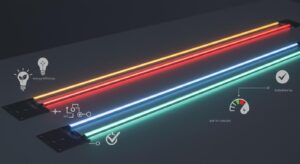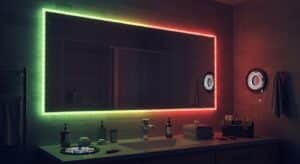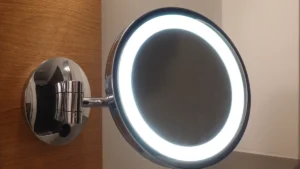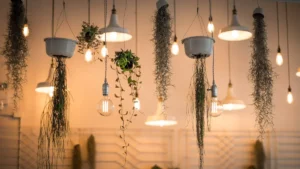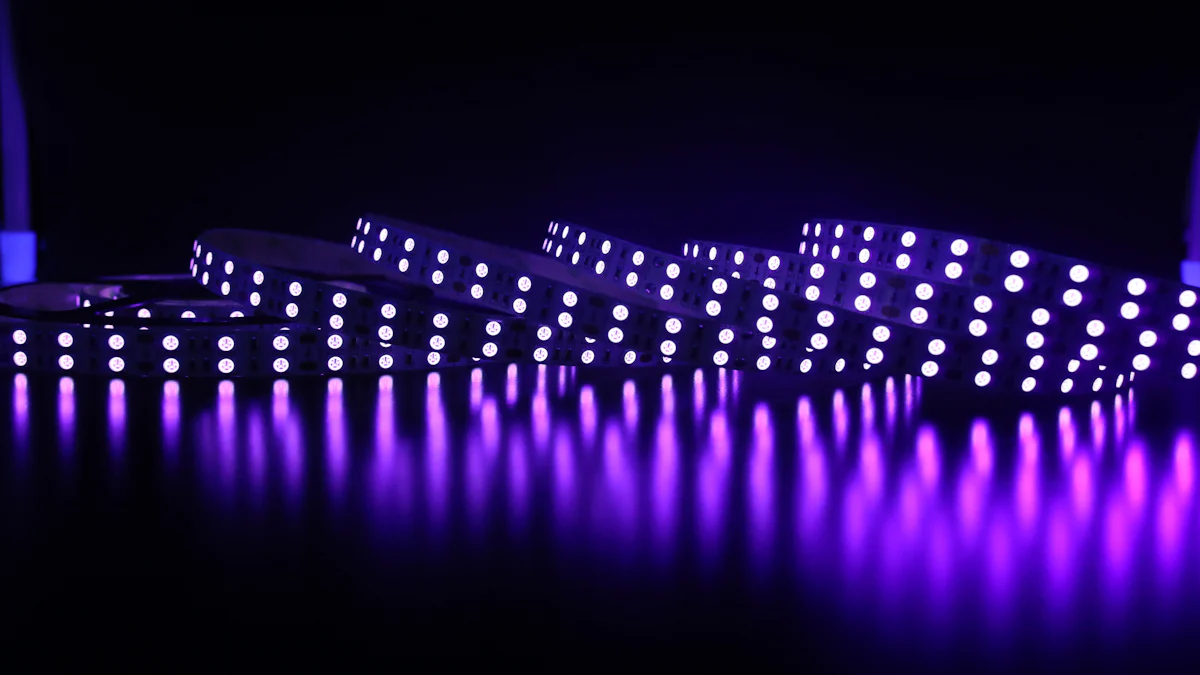
Using LED strip lights outdoors can transform your space into a vibrant and inviting area. You get to enjoy the benefits of LED lighting, which include energy efficiency and long-lasting performance. Outdoor LED strips are safe when used correctly, emitting minimal heat and posing no fire risk. They can even stay on continuously without worry. Plus, outdoor lighting has been shown to reduce crime rates by up to 39% at night, making your environment not only beautiful but also safer. So, why not brighten up your outdoor spaces with LED strips?
Key Takeaways
Choose LED strips with the appropriate IP rating (at least IP65) to ensure they can withstand outdoor conditions and prevent electrical issues.
Plan your lighting layout by identifying key areas such as pathways and patios, and assess whether you need ambient or task lighting for different activities.
Select the right attachment method for your LED strips, using adhesive backing for smooth surfaces and mounting clips for rough or humid environments.
Ensure your power supply is rated for continuous use to avoid overheating and potential hazards; industrial-grade drivers are recommended for safety.
Regularly check and maintain your LED strips to ensure secure connections and prevent damage from weather conditions like wind and moisture.
Measure your installation area carefully, accounting for corners and curves, and consider adding extra length for future expansion or adjustments.
Utilize adjustable brightness levels in your LED strips to customize the lighting for various occasions, enhancing both functionality and ambiance.
Determining the Lighting Area and Requirements
When planning to use LED strip lights outdoors, it’s crucial to determine where and how you’ll use them. This step ensures you achieve the desired effect while maintaining safety and efficiency.
Identifying Key Areas for Lighting
First, think about the areas you want to illuminate. LED strip lights can enhance various outdoor spaces, making them both functional and aesthetically pleasing.
Pathways and Walkways
Lighting up pathways is essential for safety and ambiance. You can use LED strips along the edges of walkways to guide guests and prevent accidents. These lights not only highlight the path but also add a decorative touch to your garden or yard. Consider using Inspired LED’s Outdoor LED Flexible Strips for this purpose. They are perfect for walkways and can easily connect to your current power system.
Decks, Patios, and Balconies
Decks and patios are popular spots for gatherings. Adding LED strip lights here can create a cozy atmosphere. You might want to install them under railings or along the perimeter of your deck. This setup provides subtle lighting that enhances the mood without being overpowering. Heavy Duty UL Listed Outdoor LED Strip Lights offer durability and UV protection, making them ideal for these areas.
Assessing Lighting Needs
Once you’ve identified the key areas, it’s time to assess your lighting needs. This involves deciding on the type of lighting and the brightness level you desire.
Ambient vs. Task Lighting
Consider whether you need ambient or task lighting. Ambient lighting provides general illumination, creating a warm and inviting environment. Task lighting, on the other hand, focuses on specific areas where you need more light, like a barbecue area or an outdoor kitchen. Versatile and Cost-Effective LED Strip Lights can serve both purposes, offering flexibility in design and function.
Desired Brightness Levels
Think about how bright you want your outdoor space to be. The brightness of LED strip lights is measured in lumens. For pathways, you might prefer a softer glow, while decks may require brighter lights for activities. UL Listed LED Strips for Outdoor Lighting provide customizable brightness levels, ensuring you get the right amount of light without excessive energy consumption.
By carefully planning your lighting area and requirements, you can transform your outdoor spaces into beautifully lit environments that are both safe and enjoyable.
Selecting the Appropriate Type of LED Strip
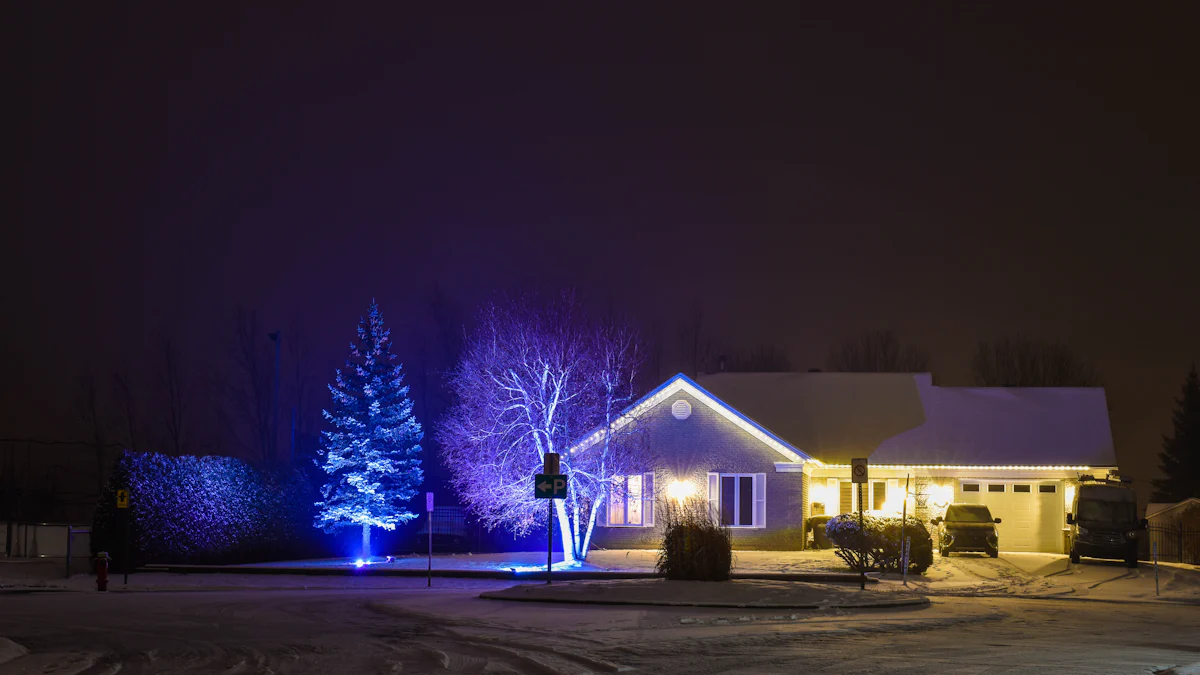
Choosing the right LED strip for your outdoor space is crucial. You want something that not only looks good but also stands up to the elements. Let’s dive into what you need to know.
Understanding Waterproof Ratings
When it comes to outdoor lighting, waterproof ratings are a big deal. They tell you how well your LED strip lights can handle dust and water.
IP Ratings Explained
IP ratings are like a secret code for durability. The first number in an IP rating shows how protected your LED strip is from solid objects like dust. The second number tells you how well it can handle liquids. For example, an IP65 rating means your LED strip lights are dust-tight and can withstand water jets. This makes them perfect for outdoor use.
Choosing the Right IP Rating for Your Environment
You need to pick an IP rating that matches your environment. If your LED strips will face heavy rain or sit near a pool, go for a higher IP rating like IP67 or IP68. These ratings ensure your lights stay safe and functional, even in wet conditions. Remember, higher IP values offer better protection, so choose wisely based on where you plan to install your lighting.
Considering Color and Brightness Options
Now, let’s talk about the fun part—color and brightness. These choices can really set the mood for your outdoor space.
Single Color vs. RGB
Do you want a classic look or something more vibrant? Single-color LED strips give you a consistent hue, perfect for a sleek and elegant vibe. On the other hand, RGB LED strips let you switch between colors, offering flexibility for different occasions. Whether you’re hosting a party or enjoying a quiet evening, RGB strips can adapt to your needs.
Lumens and Wattage Considerations
Brightness matters too. Lumens measure how bright your LED strip lights will be. More lumens mean brighter lights. Wattage, on the other hand, tells you how much energy your lights will use. You want to find a balance between brightness and energy efficiency. Look for LED strips that offer adjustable brightness levels. This way, you can customize your lighting to suit different activities and save on energy costs.
By understanding these factors, you can select LED strip lights that not only enhance your outdoor space but also last longer and perform better. Happy lighting!
Installation Considerations
When you’re setting up LED strip lights outdoors, it’s essential to think about where and how you’ll install them. This ensures they work well and last a long time.
Choosing the Right Location
Picking the perfect spot for your LED strips can make a big difference in their performance and lifespan.
Avoiding Direct Sunlight and Moisture
You want to keep your LED strips away from direct sunlight and moisture. Sunlight can cause the strips to fade or overheat, while moisture can lead to electrical issues. Look for shaded areas or spots that are naturally protected from rain. If you can’t avoid these elements, consider using LED strips with a high IP rating for extra protection.
Ensuring Accessibility for Maintenance
Make sure you can easily reach your LED strips for maintenance. You might need to clean them or check connections from time to time. Installing them in accessible areas will save you a lot of hassle later on. Think about how you’ll access them before you start the installation process.
Power Source and Safety
Powering your LED strips safely is crucial. You don’t want any electrical mishaps ruining your outdoor lighting setup.
Selecting a Suitable Power Supply
Choosing the right power supply is vital. A power supply not rated for continuous use can overheat and cause hazards. Industrial-grade drivers are usually safer because they have protections against overcurrent and thermal issues. Look for guides that help with power supply selection to ensure you pick the right one for your needs.
“Getting the right power supply for nonstop use is very important. I found out the hard way! A power supply not rated for continuous use can overheat and cause hazards.” – LED Strip Lights Expert
Ensuring Safe Electrical Connections
Make sure all your electrical connections are safe and secure. Use high-quality components and follow the manufacturer’s instructions. This reduces the risk of electrical issues and ensures your LED strips operate safely. Remember, proper installation is key to preventing accidents and prolonging the life of your lighting system.
By considering these factors, you can set up your outdoor LED strip lights safely and effectively. Enjoy the beautiful ambiance they create without worrying about potential issues.
Attachment Methods and Materials

When it comes to securing your LED strip lights outdoors, choosing the right attachment methods and materials is crucial. You want your lighting to stay put, whether it’s on your porch, balcony, or lining your pathways. Let’s explore some effective ways to ensure your LED strips remain securely attached.
Selecting Appropriate Adhesives and Mounting Options
You have a couple of options when it comes to attaching your LED strips: adhesive backing and mounting clips. Each has its own benefits and considerations.
Adhesive Backing vs. Mounting Clips
Adhesive backing offers a simple and clean installation. Many LED strips come with a strong double-sided adhesive that sticks well to most surfaces. This method is great for smooth surfaces where you want a seamless look. However, in hot, humid, or wet environments, adhesives might not hold up as well. For these conditions, mounting clips provide a more secure option. They are especially useful for heavier outdoor-rated strips, offering a long-term solution that withstands various weather conditions.
Considerations for Different Surfaces
Different surfaces require different approaches. For instance, if you’re attaching LED strips to a wooden porch or balcony, ensure the surface is clean and dry for the adhesive to bond effectively. On rough or uneven surfaces, mounting clips might be a better choice. They provide a sturdy hold and prevent the strips from drooping or falling off. Always consider the surface type before deciding on the attachment method.
Ensuring Secure and Durable Attachment
Once you’ve chosen your attachment method, focus on making sure it’s secure and durable. This involves a few key steps.
Weatherproofing Connections
Weatherproofing is essential for outdoor LED installations. Use weather-resistant adhesives or silicone-mounting brackets to protect your connections from rain and snow. This ensures your LED strips stay in place and function properly, even in harsh weather conditions.
Preventing Damage from Wind and Movement
Wind and movement can pose challenges for outdoor LED strips. To prevent damage, make sure your strips are tightly secured. Mounting clips can help keep them in place, reducing the risk of them being blown away or damaged by strong winds. Regularly check your installations to ensure everything remains secure.
By carefully selecting your attachment methods and materials, you can enjoy beautifully lit outdoor spaces without worrying about your LED strips coming loose. Whether you’re lighting up your porch, lining your balcony, or enhancing your pathways, these tips will help you achieve a secure and lasting installation.
Calculating the Required Length of LED Strips
When you’re planning to install LED strip lights outdoors, getting the right length is crucial. You don’t want to end up with too much or too little. Let’s break down how you can measure and plan effectively.
Measuring the Installation Area
Start by measuring the area where you want to install your LED strips. This step ensures you have enough lighting to cover the entire space without any gaps.
Accounting for Corners and Curves
Corners and curves can be tricky. They require extra attention because LED strips need to bend or turn at these points. Measure these areas carefully. You might need to cut the strips to fit perfectly. LED strips often have designated cut lines, making it easy to adjust the length as needed. Remember, precise measurements help you avoid unnecessary overlaps or gaps.
Allowing for Overlap and Gaps
While measuring, consider any potential overlaps or gaps. Overlapping can cause uneven lighting, while gaps might leave parts of your path or stairs in the dark. Aim for a seamless look by planning your layout meticulously. This way, you ensure consistent lighting throughout your outdoor space.
Planning for Future Expansion
Thinking ahead can save you time and effort. If you plan to expand your lighting setup later, it’s wise to account for that now.
Adding Extra Length for Flexibility
Adding a bit of extra length gives you flexibility. It allows you to adjust your setup if you decide to change the layout or add more features. This extra length can be particularly useful if you want to highlight your stairs or create a new path. Having some wiggle room means you can easily adapt your lighting to suit different occasions or moods.
Considering Additional Features or Zones
Consider any additional features or zones you might want to light up in the future. Maybe you want to set the mood for a cozy evening on your patio or illuminate a new garden path. Planning for these possibilities now means you won’t have to start from scratch later. It also ensures your lighting system remains cohesive and functional as your outdoor space evolves.
By carefully measuring and planning, you can create a stunning outdoor lighting setup that enhances your space and meets your needs. Whether you’re lighting up your stairs or creating a welcoming path, these tips will help you achieve the perfect look.
Using outdoor LED strips can transform your space into a vibrant and inviting area. To ensure safety, always choose LED strips with the right IP rating for your environment. Proper installation and maintenance are key. Secure your strips with appropriate adhesives or mounting clips, and regularly check connections to prevent damage. Outdoor LED strip lights offer practical outdoor lighting solutions, enhancing your garden, pathways, and decks. They create a beautiful mood, whether you’re outlining flower beds or adding path lighting. Enjoy the benefits of buying outdoor LED strip lights and let your creativity shine!
FAQ
How do I adhere outdoor-rated strip lights?
To adhere outdoor-rated strip lights effectively, you should consider the surface and environmental conditions. For smooth surfaces, use the adhesive backing that comes with many LED strips. It provides a clean and seamless look. However, in humid or wet environments, mounting clips offer a more secure option. They ensure your lights stay put, even in challenging weather. Always clean the surface before applying adhesive or clips for the best results.
Can I use indoor LED strips for outdoor lighting?
Using indoor LED strips outdoors is not recommended. Indoor strips lack the necessary protection against moisture and dust. This can lead to electrical issues or even pose a fire hazard. Always choose LED strips specifically rated for outdoor use. These strips have higher IP ratings, ensuring they withstand outdoor conditions safely.
What IP rating should I look for in outdoor lighting?
For outdoor lighting, aim for an IP rating of at least IP65. This rating ensures your LED strips are dust-tight and can handle water jets from any direction. If your lights will be exposed to heavy rain or near a pool, consider IP67 or IP68. These ratings offer even greater protection, keeping your lights safe and functional.
How do I ensure my LED strips are weatherproof?
To weatherproof your LED strips, use RTV 4500 Silicon Sealant or any outdoor-rated clear silicone sealant. Apply it to connections and exposed areas to prevent moisture ingress. This step is crucial for maintaining the longevity and performance of your outdoor lighting.
What power supply should I use for outdoor LED strips?
Select a power supply that matches the voltage and wattage requirements of your LED strips. Industrial-grade drivers are ideal as they offer protections against overcurrent and thermal issues. Ensure your power supply is rated for continuous use to avoid overheating and potential hazards.
How can I prevent damage from wind and movement?
To prevent damage from wind and movement, secure your LED strips with mounting clips. These clips provide a sturdy hold, reducing the risk of your strips being blown away or damaged. Regularly check your installations to ensure everything remains secure.
Can I adjust the brightness of outdoor LED strips?
Yes, many outdoor LED strips offer adjustable brightness levels. This feature allows you to customize the lighting to suit different activities or moods. Look for LED strips with dimming capabilities to enjoy flexible outdoor lighting.
How do I calculate the required length of LED strips?
Measure the installation area carefully, accounting for corners and curves. Consider potential overlaps or gaps to ensure consistent lighting. Adding extra length provides flexibility for future expansion or layout changes.
Are there specific colors recommended for outdoor lighting?
White LED strips with adjustable color temperatures are often preferred for outdoor lighting. They provide practical illumination for walkways and patios. RGB strips offer vibrant options for creating different moods and settings.
What are the benefits of using outdoor LED strip lights?
Outdoor LED strip lights enhance your space with energy-efficient and long-lasting illumination. They create a beautiful ambiance, improve safety, and can even reduce crime rates. Whether you’re outlining flower beds or adding path lighting, these lights offer versatile solutions for your outdoor lighting needs.
See Also
Ultimate Handbook for Outdoor LED Light Strips
Selecting the Perfect LED Strip Lights for Linear Lighting
Effective Installation Tips for RGB LED Strip Lights
